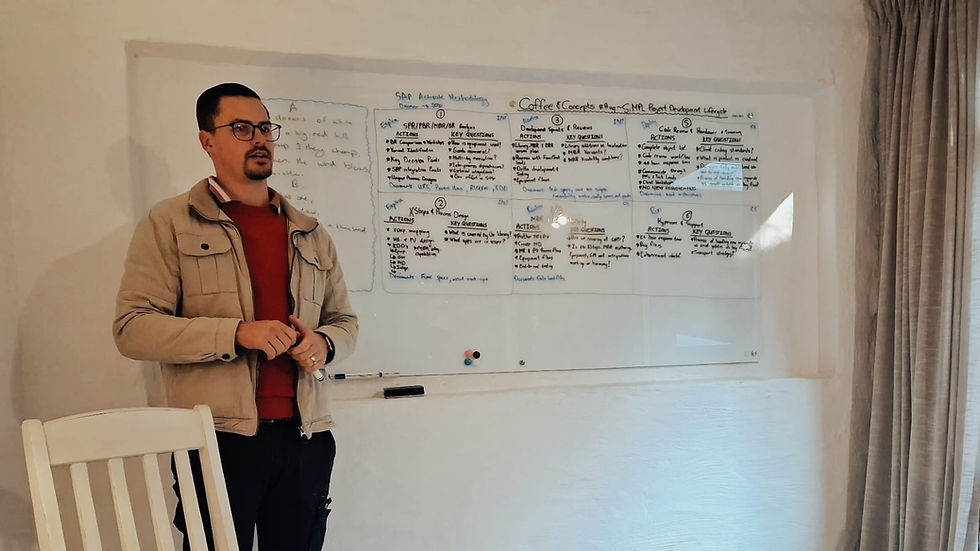Lunch & Learn Recap: SiMPL Project Development Lifecycle & Key Integration Points
- keeanferreira
- Sep 15
- 3 min read
At our recent Lunch & Learn session, we explored the development lifecycle we follow when integrating the SiMPL application suite in a client system. Presented by Gustav Grotius.

Delivering SAP Projects with SAP Activate
Delivering a successful SAP project requires both a structured framework and close collaboration between teams and clients. The SAP Activate methodology provides exactly that — guiding projects from initial discussions through to post-go-live support.
When we implement the SiMPL Application Suite in a client system, we leverage this methodology, with a few tailored twists. Let’s break it down.
Project Flow with SAP Activate
Most projects span 12–18 months and follow these phases:
Discover – Pre-project discussions and solution exploration.
Explore – Analyze client systems and processes to prepare for development.
Realize – Build and configure the solution.
MBR & EBR Authoring – Complete build deliverables and conduct end-to-end testing.
Deploy – Code review, handover, and training.
Run/Hypercare Support – Stabilize operations and capture enhancements post-go-live.
Discover – Setting the Stage
This is where commercial discussions, insights, and pre-sales activities happen. During Discover, the team:
Establishes the business case and value.
Studies client expectations.
Drafts the scope outline.
It’s about setting the vision and ensuring all parties are aligned before moving forward.
Explore – Understanding the Landscape
Once the vision and feasibility are clear, the project moves into Explore. The focus shifts to gaining a deep understanding of the client’s environment and identifying challenges.
A major activity here is the analysis of paper batch records (SBR, PBR, MBR) to uncover:
Interdependencies
External integrations
Equipment usage
Goods movements
This helps identify similarities that can be standardized into reusable build components.
Work during Explore is often done in sandbox environments, where processes can be tested safely. As work matures, development transitions into client systems for final testing and handover.
A key outcome of Explore is the documentation of Key Decision Points (KDDs). These are critical agreements—covering equipment, goods movement, integrations, and master data—that prevent scope creep and ensure early decisions remain locked in.
Realize – Building the Solution
In the Realize phase, designs and requirements are transformed into working solutions. This includes:
X-Step and process design within internal systems, leveraging library components where possible.
Creating functional specifications and mockups, ideally before development begins (though overlap is common).
Running development sprints and reviews, balancing library additions with localized developments.
Producing essential documentation such as technical specs, unit test scripts, traceability matrices, configuration specs, and installation guides.
This is typically the longest phase of the project and requires constant collaboration between functional leads, technical teams, and business analysts.
MBR/EBR Authoring – End-to-End Testing
Here, all development work is brought together for end-to-end testing. Newly built XSteps are used when authoring Master Recipes (MBR) and executing them in Electronic Batch Records (EBR).
Key aspects include:
Validating that the solution matches initial requirements.
Conducting thorough internal testing before client handover.
Using data load files to move master recipe configurations across systems.
The emphasis is on minimizing bugs and ensuring stability before deployment.
Deploy – Handover and Training
The Deploy phase is one of the most sensitive stages, as the solution is formally handed over to the client.
Activities include:
Performing code reviews to ensure compliance with client standards.
Delivering work instructions with screenshots as a practical handbook.
Managing expectations — distinguishing between bug fixes, small updates, and new requests (which are usually deferred).
Providing a complete object list of all components moved into client systems.
Clear communication is essential here, with technical and functional leads guiding discussions and preventing scope creep.
Run – Stabilizing and Supporting
Also called Hypercare Support, this phase focuses on stability and responsiveness as clients move into production.
Key priorities include:
Delivering rapid turnaround times for issues.
Managing enhancement requests carefully.
Ensuring deployment and transport strategies align with client expectations.
This is the phase where trust is solidified, and long-term client satisfaction hinges on effective support.
Broader Application of SAP Activate
While the focus here is on implementing the SiMPL Application Suite, the SAP Activate methodology is widely applicable. It supports greenfield, brownfield, migration, and cloud transformation projects.
Tools like SAP CALM (Cloud Application Lifecycle Management) further strengthen delivery by helping manage projects across complex system landscapes.



